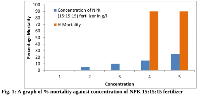Acute Toxicity of Inorganic Fertilizer, NPK (15:15:15) on Some Biological Parameters of African Catfish (Clarias gariepinus) Burchell, 1822
Keywords:
Clarias gariepinus, inorganic fertilizer, mortality, biological effectsAbstract
Acute toxicity effects of inorganic fertilizer, NPK (15:15:15) on African Catfish (Clarias gariepinus) Burchell, 1822, was carried out under laboratory conditions. One hundred and fifty fingerlings of the fish of weight and length 4.5g and 3.9cm respectively, were acclimatized for 14 days. The test fish were divided into five groups (1-5) with 10 fish per group in triplicates. The concentrations were 0.00g/l, 5.00g/l, 15.00g/l, and 25.00g/l of NPK (15:15:15) fertilizer after a preliminary range-finding test. Results showed that the mortality rate increased in concentration and duration of exposure. After 96 hours, mortality was not recorded in the control. 5g/l concentration recorded 10% mortality but increased to 50% in the 10g/l, while the 15g/l and 25g/l recorded 90% mortality. There was a significant difference at p<0.05 in the 5g/l concentration as compared to the 10g/l and 15g/l concentration. The biological effects of the fertilizer in the exposed fish gills were concentration-dependent. It is therefore recommended that excess inorganic fertilizer, NPK (15:15:15) should not be used for pond fertilization to avoid deleterious effects on the fish.
Downloads
References
Alabaster, J.S. and Lloyd, R. (1980). Water quality criteria for fresh water fish.Agriculture, Ecosystems and Environment, 74(1), pp. 19-31.
Altug, T. (2002). Introduction to toxicology and food. (CRC Press). Water pollution and human health in China. Environmental Health Perspectives, 107(4), p251.
Atkins, J.P., Burdon, D., Elliott, M., and Gregory, A.J. (2011). Management of the marine environment: integrating ecosystem services and societal benefits with the DPSIR framework in a systems approach. Marine Pollution Bulletin, 62(2), 215-226.
Barg, U.C. (1992). Guidelines for the promotion of environmentalmanagement of coastal aquaculture development (No. 328). Food and Agriculture Organization.
Benton, T., and Redcliff, M. (2013). Social theory and the global environment. Routledge
Briggs, M.R.P., and Fvnge-Smith, S.J. (1994). A nutrient budget of someintensive marine shrimp ponds in Thailand. Aquaculture Research, 25(8), pp. 789-811.
Brungs, W.A (1973). Continuous flow bioassays with aquatic organism: procedures and applications. In: Biological methods for the assessment of water quality. ASTM International. pp. 117-126.
Dudka, S., and Miller, W.P. (1999). Accumulation of potentially toxic elements in plants and their transfer to human food chain. Journal of Environmental Science and Health Part B, 34(4), 681-708.
Edwards, M.R. (2008). Green Algae Strategy: End Biowar I and Engineer Sustainable Food and Biofuel. Lulu.com.
Francis-Floyd, P.A. (1992). Submitting a sample for fish kill investigation. Southern Regional Aquaculture Center Publication 472, Mississippi State Univ. MS.
Geyer, H.J., Rimkus, G.G., Scheunert, I., Kaune, A., Schramm, K.W., Kettrup, A., and Mackay, D. (2000). Bioaccumulation and occurrence of endocrine-disrupting chemicals (EDCs), persistent organic pollutants (POPs), and other organic compounds in fish and other organisms including humans. In: Bioaccumulation-New Aspects Developments. Springer Berlin Heidelberg pp. 1-166.
Health, A.G. (1995). Water Pollution and fish physiology. Second Edition. CRC Press Inc., Florida. pp. 359.
Iroegbu, B.C, Hart, A.I and Abowei, J.F.N. (2008). Survival response of Sarotherodon melanotheron (Ruppel, 1852) fingerlings to various concentration levels of perfekthion under laboratory condition. Journal of Applied Science and Environmental Management (JASEM) 12(12): 47-54.
Jafee, S., and Henson, S. (2004). Standards and Agro-food exports from developing countries: rebalancing the debate (Vol. 3348). World Bank Publications.
Jensen, E. S., and Hauggaard-Nielsen, H. (2003). How can increased use of biological N2 fixation in agriculture benefit the environment? Plant and Soil, 252(1), pp. 177-186.
Nussey, G. (1994). The effect of copper on blood coagulation. (Cichilidae). M.Sc. Thesis, Rand Afrikaans University, Johannesburg, South Africa.
Rottman, R.W., Francis-Floyd, R. (1992). The role of stress in fish diseases. Southern Regional Aquaculture Centre (SRAC) Publishing, p.474.
Siavoshi, M., and Laware, S.L. (2011). Effect of organic fertilizer on growth and yield components in rice (Oryza sativa L.). Journal of Agricultural Science, 3(3), pp. 217.
Snyder, C.S., Bruulsema, T.W., Jensen, T.L., and Fixen, P.E. (2009). Review of greenhouse gas emissions from crop production systems and fertilizer management effects. Agriculture, Ecosystems and Environment, 133(3), 247-266.
Sprague, J.B. (1971). Measurement of pollutant toxicity to fish-III: Sub lethal effects and “safe” concentrations. Water Research,5(6), 245-266.
Temilsina, G.R., and Shrestha, A. (2010). Biofuels: markets, targets and impacts. World Bank Policy Research Working Paper Series,56(3), 123-231.
Van Der Merve, M., (1993). Aspects of heavy metal concentration in the Oilfants River, Kruger National Park and the effect of copper on the hematology of Clarias gariepinus(Claridae). M.Sc. Thesis, Rand Afrikaans University, South Africa.
Van der Oost, J., Beyer, J, and Vermeulen, N.P. (2003). Fish bioaccumulation and biomarkers in environmental risk assessment: a review. Environ Toxicol Pharmacol. 13(2):15-149
Verhoeven, J.T.A., and Schmitz, M.B. (1991). Control of plant growth by nitrogen and phosphorus in mesotrophic fens. Biogeochemistry, 12(2), pp. 135-148

Downloads
Published
Issue
Section
License

This work is licensed under a Creative Commons Attribution-NonCommercial-ShareAlike 4.0 International License.







